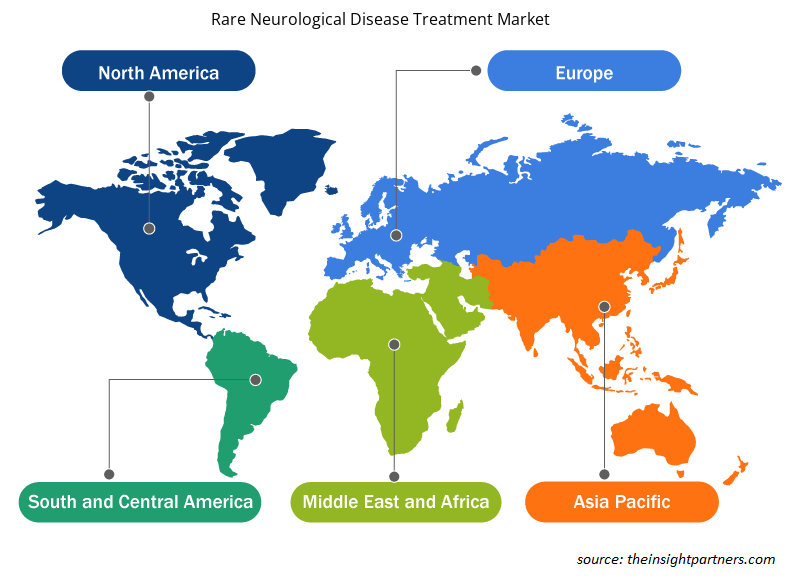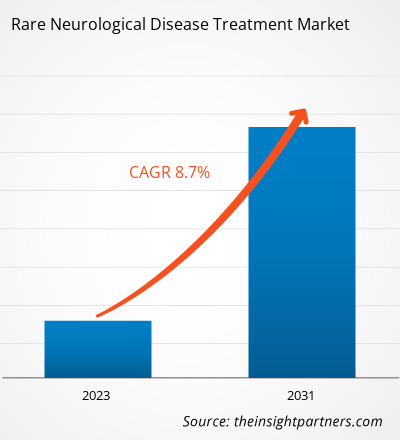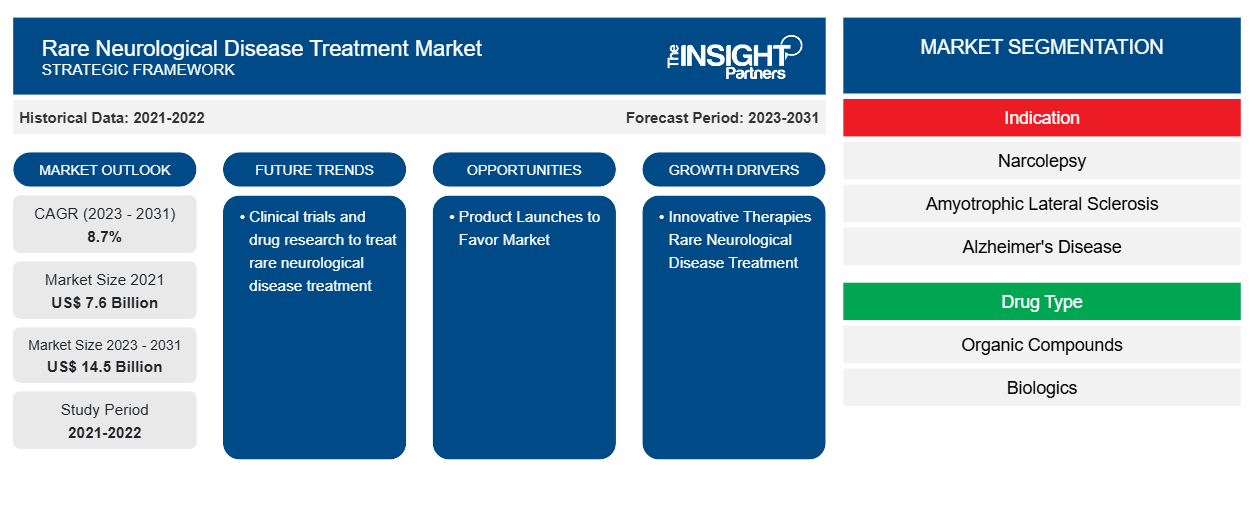El mercado de tratamiento de enfermedades neurológicas raras se valoró en 7.600 millones de dólares estadounidenses en 2021 y se espera que alcance los 14.500 millones de dólares estadounidenses en 2031. Se espera que el mercado registre una CAGR del 8,7 % entre 2023 y 2031. Es probable que los ensayos clínicos y la investigación de fármacos para tratar enfermedades neurológicas raras sigan siendo tendencias clave del mercado de tratamiento de enfermedades neurológicas raras.
Análisis de mercado de tratamiento de enfermedades neurológicas raras
Terapias innovadoras para el tratamiento de enfermedades neurológicas raras
El Centro de Evaluación e Investigación de Medicamentos (CDER) anunció en 2023 la aprobación de la primera terapia de reemplazo enzimático para tratar los efectos no neurológicos de la alfa-manosidosis (un trastorno genético poco común de almacenamiento lisosomal). Además, en marzo de 2024, un estudio clínico descubrió que una terapia génica en investigación puede ayudar a los pacientes con enfermedades neurodegenerativas raras. Además, en mayo de 2022, se estableció el Programa de Aceleración de Curas de Enfermedades Raras (ARC) para impulsar la innovación y el compromiso científicos y regulatorios para acelerar la disponibilidad de tratamiento para pacientes con enfermedades raras. La FDA aprovechará la infraestructura, la experiencia y el liderazgo estratégico del Programa ARC para establecer un Grupo de Trabajo sobre Enfermedades Neurodegenerativas Raras entre centros. Los factores mencionados anteriormente son responsables del influyente crecimiento del mercado de tratamiento de enfermedades neurológicas raras durante 2021-2031.
Descripción general del mercado de tratamiento de enfermedades neurológicas raras
La tecnología, la innovación y las soluciones tecnológicas inteligentes siguen influyendo significativamente en el mercado de tratamiento de enfermedades neurológicas raras. Las terapias innovadoras para el tratamiento de enfermedades neurológicas raras y los lanzamientos de productos son los factores más influyentes responsables del crecimiento del mercado de tratamiento de enfermedades neurológicas raras. Los ensayos clínicos y la investigación de fármacos para el tratamiento de enfermedades neurológicas raras son una tendencia clave para el crecimiento del mercado de tratamiento de enfermedades neurológicas raras. El aumento de las actividades de investigación y desarrollo (I+D) brindará una oportunidad de mercado lucrativa.
Personalice este informe según sus necesidades
Obtendrá personalización en cualquier informe, sin cargo, incluidas partes de este informe o análisis a nivel de país, paquete de datos de Excel, así como también grandes ofertas y descuentos para empresas emergentes y universidades.
-
Obtenga las principales tendencias clave del mercado de este informe.Esta muestra GRATUITA incluirá análisis de datos, desde tendencias del mercado hasta estimaciones y pronósticos.
Tratamiento de enfermedades neurológicas raras Factores impulsores y oportunidades del mercado
Lanzamientos de productos para favorecer el mercado
En noviembre de 2022, CENTOGENE anunció el lanzamiento de "Biodata Network", una cartera de datos basados en enfermedades raras y neurodegenerativas para institutos de investigación y biofarmacéuticos. Además, los conjuntos de datos de CENTOGENE representan un aumento estimado del 20 % tanto en la amplitud como en la profundidad de los datos genómicos actualmente disponibles a través de las plataformas de BC. Este conjunto de datos refleja una base de muestra geográfica y étnica diversa que incluye la prevalencia de casos pediátricos que padecen enfermedades raras y neurodegenerativas, incluidos datos clínicos, multiómicos y sociodemográficos. Por lo tanto, estos conjuntos de datos innovadores de lanzamiento de productos para el tratamiento de enfermedades neurológicas raras contribuirán significativamente en los próximos años.
Aumento de las actividades de investigación y desarrollo (I+D): una oportunidad
- En diciembre de 2023, la Administración de Alimentos y Medicamentos (FDA) anunció subvenciones y contratos a entidades públicas y privadas que cubren el costo de la investigación y el desarrollo (I+D) para prevenir, diagnosticar, mitigar, tratar y curar la esclerosis lateral amiotrófica (ELA) y otras enfermedades neurodegenerativas graves en adultos y niños.
- En junio de 2023, Ipsen y Medentia anunciaron una colaboración para el descubrimiento de fármacos y la química medicinal. A través de esta colaboración, las empresas aportarán en conjunto nuevas soluciones a personas de todo el mundo, centrándose en las enfermedades raras, incluidas las enfermedades neurodegenerativas raras.
Por lo tanto, el aumento de las actividades de I+D brindará oportunidades de mercado lucrativas que representarán una participación de mercado considerable en los próximos años para el mercado de tratamiento de enfermedades neurológicas raras.
Tratamiento de enfermedades neurológicas raras
Análisis de segmentación de informes de mercado
Los segmentos clave que contribuyeron a la derivación del análisis del mercado de tratamiento de enfermedades neurológicas raras son la candidatura y los servicios.
- Según las indicaciones, el mercado de tratamiento de enfermedades neurológicas raras se segmenta en narcolepsia, esclerosis lateral amiotrófica, enfermedad de Alzheimer, esclerosis múltiple, atrofia muscular espinal, distrofia muscular de Duchenne y otras. La enfermedad de Alzheimer podría tener una mayor participación de mercado en 2023.
- Según el tipo de fármaco, el mercado de tratamiento de enfermedades neurológicas raras se divide en compuestos orgánicos y productos biológicos. Los productos biológicos podrían tener una mayor participación de mercado en 2023.
- Según el modo de administración, el mercado de tratamiento de enfermedades neurológicas raras se divide en oral e inyectable. El segmento oral podría tener una mayor participación de mercado en 2023.
- Según el canal de distribución, el mercado de tratamiento de enfermedades neurológicas raras se segmenta en farmacias hospitalarias, farmacias minoristas y otras. El segmento de farmacias hospitalarias puede tener una mayor participación de mercado en 2023.
Análisis de la cuota de mercado del tratamiento de enfermedades neurológicas raras por geografía
El alcance geográfico del informe de mercado de tratamiento de enfermedades neurológicas raras se divide principalmente en cinco regiones: América del Norte, Asia Pacífico, Europa, Medio Oriente y África, y América del Sur / América del Sur y Central.
América del Norte ha dominado el mercado de tratamiento de enfermedades neurológicas raras. En América del Norte, Estados Unidos representa una parte considerable del tratamiento de enfermedades neurológicas raras. La presencia de los principales fabricantes en Estados Unidos y el aumento de las actividades de I+D son los factores más influyentes responsables del crecimiento del mercado. Se prevé que Asia Pacífico crezca con la CAGR más alta en los próximos años.
Tratamiento de enfermedades neurológicas raras
Perspectivas regionales del mercado de tratamiento de enfermedades neurológicas raras
Los analistas de Insight Partners explicaron en detalle las tendencias y los factores regionales que influyen en el mercado de tratamiento de enfermedades neurológicas raras durante el período de pronóstico. Esta sección también analiza los segmentos y la geografía del mercado de tratamiento de enfermedades neurológicas raras en América del Norte, Europa, Asia Pacífico, Oriente Medio y África, y América del Sur y Central.

- Obtenga datos regionales específicos para el mercado de tratamiento de enfermedades neurológicas raras
Alcance del informe de mercado sobre el tratamiento de enfermedades neurológicas raras
| Atributo del informe | Detalles |
|---|---|
| Tamaño del mercado en 2021 | 7.600 millones de dólares estadounidenses |
| Tamaño del mercado en 2031 | 14.500 millones de dólares estadounidenses |
| CAGR global (2023 - 2031) | 8,7% |
| Datos históricos | 2021-2022 |
| Período de pronóstico | 2023-2031 |
| Segmentos cubiertos |
Por indicación
|
| Regiones y países cubiertos |
América del norte
|
| Líderes del mercado y perfiles de empresas clave |
|
Densidad de actores del mercado de tratamiento de enfermedades neurológicas raras: comprensión de su impacto en la dinámica empresarial
El mercado de tratamiento de enfermedades neurológicas raras está creciendo rápidamente, impulsado por la creciente demanda de los usuarios finales debido a factores como la evolución de las preferencias de los consumidores, los avances tecnológicos y una mayor conciencia de los beneficios del producto. A medida que aumenta la demanda, las empresas amplían sus ofertas, innovan para satisfacer las necesidades de los consumidores y aprovechan las tendencias emergentes, lo que impulsa aún más el crecimiento del mercado.
La densidad de actores del mercado se refiere a la distribución de las empresas o firmas que operan dentro de un mercado o industria en particular. Indica cuántos competidores (actores del mercado) están presentes en un espacio de mercado determinado en relación con su tamaño o valor total de mercado.
Las principales empresas que operan en el mercado de tratamiento de enfermedades neurológicas raras son:
- Allergan (AbbVie) Inc.,
- Bayer AG,
- GlaxoSmithKline plc,
- Servicios Johnson & Johnson, Inc.,
- Merck & Co., Inc.,
- Novartis,
Descargo de responsabilidad : Las empresas enumeradas anteriormente no están clasificadas en ningún orden particular.

- Obtenga una descripción general de los principales actores clave del mercado de tratamiento de enfermedades neurológicas raras
Noticias del mercado y desarrollos recientes sobre el tratamiento de enfermedades neurológicas raras
El mercado de tratamiento de enfermedades neurológicas raras se evalúa mediante la recopilación de datos cualitativos y cuantitativos posteriores a la investigación primaria y secundaria, que incluye publicaciones corporativas importantes, datos de asociaciones y bases de datos. A continuación, se incluye una lista de los desarrollos en el mercado de tratamiento de enfermedades neurológicas raras y las estrategias:
- En septiembre de 2022, la Administración de Alimentos y Medicamentos de los EE. UU. (USFDA) y el Instituto Nacional de Salud (NIH) anunciaron el lanzamiento de la "Ruta crítica para las enfermedades neurodegenerativas raras (CP-RND)", una asociación público-privada que tiene como objetivo avanzar en la comprensión de las enfermedades neurodegenerativas que fomenten el desarrollo de tratamientos para la esclerosis lateral amiotrófica (ELA) y otras enfermedades neurodegenerativas raras.
Informe de mercado sobre el tratamiento de enfermedades neurológicas raras: cobertura y resultados
El informe “Tamaño y pronóstico del mercado de tratamiento de enfermedades neurológicas raras (2021-2031)” proporciona un análisis detallado del mercado que cubre las siguientes áreas:
- Tamaño del mercado y pronóstico a nivel global, regional y nacional para todos los segmentos clave del mercado cubiertos bajo el alcance
- Dinámica del mercado, como impulsores, restricciones y oportunidades clave
- Principales tendencias futuras
- Análisis detallado de las cinco fuerzas de Porter y PEST y FODA
- Análisis del mercado global y regional que cubre las tendencias clave del mercado, los principales actores, las regulaciones y los desarrollos recientes del mercado.
- Análisis del panorama de la industria y de la competencia que abarca la concentración del mercado, el análisis de mapas de calor, los actores destacados y los desarrollos recientes
- Perfiles detallados de empresas
- Análisis histórico (2 años), año base, pronóstico (7 años) con CAGR
- Análisis PEST y FODA
- Tamaño del mercado, valor/volumen: global, regional y nacional
- Industria y panorama competitivo
- Conjunto de datos de Excel
Informes recientes
Testimonios
Razón para comprar
- Toma de decisiones informada
- Comprensión de la dinámica del mercado
- Análisis competitivo
- Información sobre clientes
- Pronósticos del mercado
- Mitigación de riesgos
- Planificación estratégica
- Justificación de la inversión
- Identificación de mercados emergentes
- Mejora de las estrategias de marketing
- Impulso de la eficiencia operativa
- Alineación con las tendencias regulatorias























 Obtenga una muestra gratuita para - Mercado de tratamiento de enfermedades neurológicas raras
Obtenga una muestra gratuita para - Mercado de tratamiento de enfermedades neurológicas raras